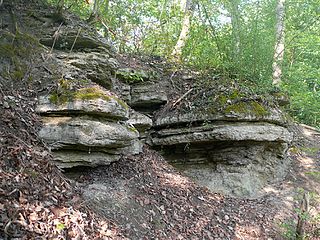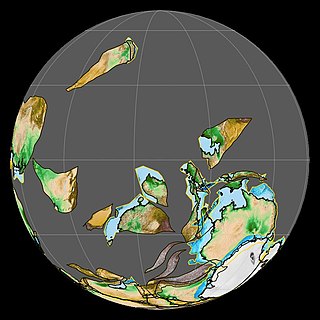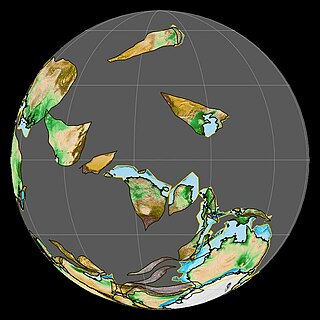Related Research Articles

The Carboniferous is a geologic period and system of the Paleozoic that spans 60 million years from the end of the Devonian Period 358.9 Ma to the beginning of the Permian Period, 298.9 Ma. In North America, the Carboniferous is often treated as two separate geological periods, the earlier Mississippian and the later Pennsylvanian.

In the geologic timescale, the Anisian is the lower stage or earliest age of the Middle Triassic series or epoch and lasted from 247.2 million years ago until 242 million years ago. The Anisian Age succeeds the Olenekian Age and precedes the Ladinian Age.
In the geologic timescale, the Asselian is the earliest geochronologic age or lowermost chronostratigraphic stage of the Permian. It is a subdivision of the Cisuralian Epoch or Series. The Asselian lasted between 298.9 and 293.52 million years ago (Ma). It was preceded by the Gzhelian and followed by the Sakmarian.
The Bashkirian is in the International Commission on Stratigraphy geologic timescale the lowest stage or oldest age of the Pennsylvanian. The Bashkirian age lasted from 323.2 to 315.2 Ma, is preceded by the Serpukhovian and is followed by the Moscovian.
In the geologic timescale, the Valanginian is an age or stage of the Early or Lower Cretaceous. It spans between 139.8 ± 3.0 Ma and 132.6 ± 2.0 Ma. The Valanginian Stage succeeds the Berriasian Stage of the Lower Cretaceous and precedes the Hauterivian Stage of the Lower Cretaceous.

The Tournaisian is in the ICS geologic timescale the lowest stage or oldest age of the Mississippian, the oldest subsystem of the Carboniferous. The Tournaisian age lasted from 358.9 Ma to 346.7 Ma. It is preceded by the Famennian and is followed by the Viséan. In global stratigraphy, the Tournaisian contains two substages: the Hastarian and Ivorian. These two substages were originally designated as European regional stages.

The Serpukhovian is in the ICS geologic timescale the uppermost stage or youngest age of the Mississippian, the lower subsystem of the Carboniferous. The Serpukhovian age lasted from 330.9 Ma to 323.2 Ma. It is preceded by the Visean and is followed by the Bashkirian. The Serpukhovian correlates with the lower part of the Namurian Stage of European stratigraphy and the middle and upper parts of the Chesterian Stage of North American stratigraphy.
The Kasimovian is a geochronologic age or chronostratigraphic stage in the ICS geologic timescale. It is the third stage in the Pennsylvanian, lasting from 307 to 303.7 Ma. The Kasimovian Stage follows the Moscovian and is followed by the Gzhelian. The Kasimovian saw an extinction event which occurred around 305 mya, referred to as the Carboniferous Rainforest Collapse. It roughly corresponds to the Missourian in North American geochronology and the Stephanian in western European geochronology.

The Gzhelian is an age in the ICS geologic timescale or a stage in the stratigraphic column. It is the youngest stage of the Pennsylvanian, the youngest subsystem of the Carboniferous. The Gzhelian lasted from 303.7 to 298.9 Ma. It follows the Kasimovian age/stage and is followed by the Asselian age/stage, the oldest subdivision of the Permian system.
The Moscovian is in the ICS geologic timescale a stage or age in the Pennsylvanian, the youngest subsystem of the Carboniferous. The Moscovian age lasted from 315.2 to 307 Ma, is preceded by the Bashkirian and is followed by the Kasimovian. The Moscovian overlaps with the European regional Westphalian stage and the North American Atokan and Desmoinesian stages.
The Westphalian is a regional stage or age in the regional stratigraphy of northwest Europe, with an age between roughly 315 and 307 Ma. It is a subdivision of the Carboniferous System or Period and the regional Silesian Series. The Westphalian is named for the region of Westphalia in western Germany where strata of this age occur. The Coal Measures of England and Wales are also largely of Westphalian age, though they also extend into the succeeding Stephanian.
The Norian is a division of the Triassic Period. It has the rank of an age (geochronology) or stage (chronostratigraphy). It lasted from ~227 to 208.5 million years ago. It was preceded by the Carnian and succeeded by the Rhaetian.

The Eyam Limestone is a geologic formation in the Peak District, England. It preserves fossils dating back to the Viséan stage of the Carboniferous period, and represents a marine environment.
Idiognathodus is an extinct conodont genus in the family Idiognathodontidae.
Streptognathodus is an extinct genus of conodonts from the Late Carboniferous to Early Permian.
Conodonts are an extinct class of animals whose feeding apparatuses called teeth or elements are common microfossils found in strata dating from the Stage 10 of the Furongian, the fourth and final series of the Cambrian, to the Rhaetian stage of the Late Triassic. These elements can be used alternatively to or in correlation with other types of fossils in the subfield of the stratigraphy named biostratigraphy.
Siphonodella is an extinct genus of conodonts.
Neognathodus is an extinct genus of conodonts.
Idiognathoides is an extinct genus of conodonts.
Cryptotaxidae is an extinct family of conodonts in the order Ozarkodinida. It includes the extinct genus Cryptotaxis.
References
- ↑ New Pennsylvanian Platform Conodonts from Southwestern United States. D. L. Dunn, Journal of Paleontology, Vol. 40, No. 6 (Nov., 1966), pages 1294-1303 (Stable URL)
- Early evolution of Declinognathodus close to the Mid-Carboniferous Boundary interval in the Barcaliente type section (Spain). Javier Sanz-López and Silvia Blanco-Ferrera, Palaeontology, September 2013, Volume 56, Issue 5, pages 927–946, doi : 10.1111/pala.12025
- Conodont chronostratigraphical resolution and Declinognathodus evolution close to the Mid-Carboniferous Boundary in the Barcaliente Formation type section, NW Spain. Javier Sanz-López, Silvia Blanco-Ferrera and Luis C. Sánchez de Posada, Lethaia, October 2013, Volume 46, Issue 4, pages 438–453, doi : 10.1111/let.12021